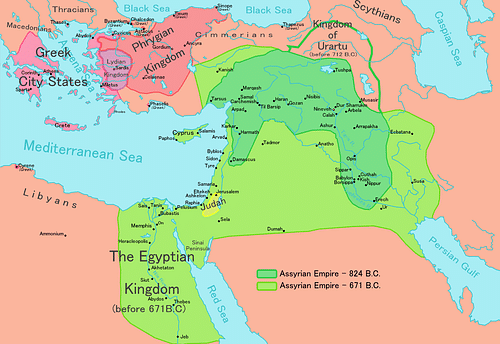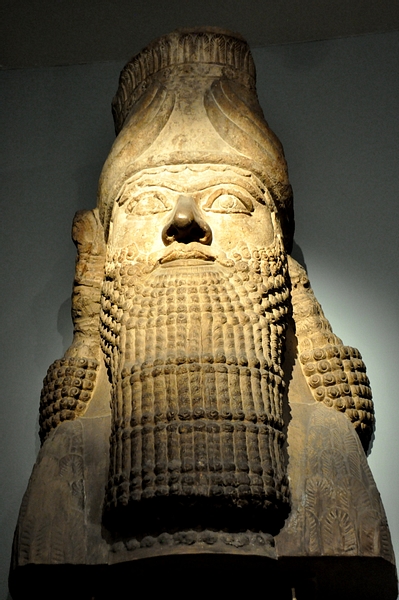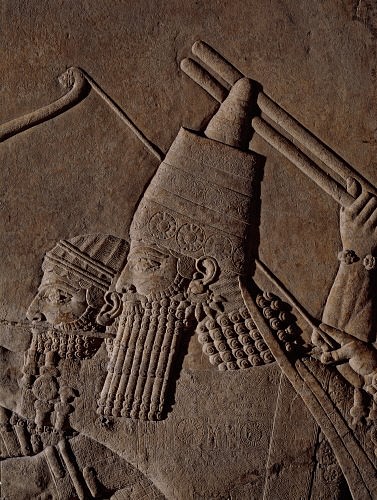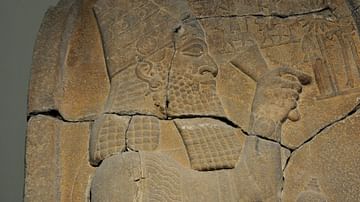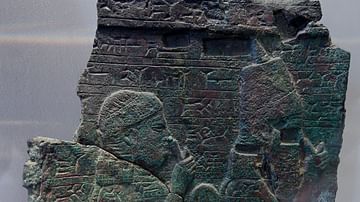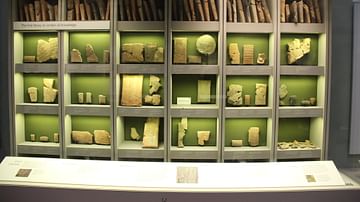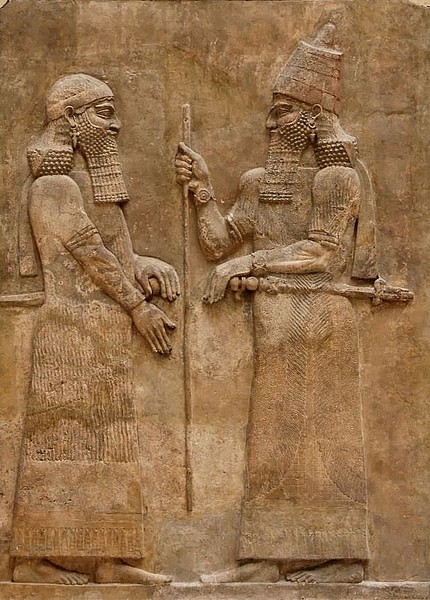
The Sargonid Dynasty was the last ruling house of the Neo-Assyrian Empire from 722-612 BCE, beginning with the reign of Sargon II and ending with fall of the Neo-Assyrian Empire. Some of the most famous kings in the history of Assyria come from this dynasty which is considered the high point of the empire.
The last great king was Ashurbanipal (r. 668-627 BCE), most famous for his library at Nineveh; following his death, his sons could not maintain the empire and it broke apart. Invading coalitions of those people who had felt oppressed by Assyrian rule ravaged the land and burned the cities in 612 BCE and, afterwards, the territory was divided and governed by these diverse cultures.
Tiglath Pileser III & Shalmaneser V: Pre-Sargonid Kings
Although the Sargonid Dynasty begins with Sargon II, he was provided with the resources to begin his successful reign by his father, Tiglath Pileser III (r. 745-727 BCE), who reorganized the military and restructured the government. According to scholar Simon Anglim:
Tiglath Pileser III carried out extensive reforms of the army, reasserted central control over the empire, reconquered the Mediterranean seaboard, and even subjugated Babylon. He replaced conscription [in the military] with a manpower levy imposed on each province and also demanded contingents from vassal states. (14)
He defeated the kingdom of Urartu, which had again risen to trouble Assyrian rulers, and subjugated the region of Syria. According to some scholars, the Neo-Assyrian Empire actually begins with Tiglath Pileser III. Scholar Gwendolyn Leick, for example, writes:
In the time between 745 and 705 BC, the Assyrian Empire took shape. This was the result not only of renewed military expansion but also of new administrative structures that ensured much tighter political and fiscal control. (127)
Under Tiglath Pileser III's reign, the Assyrian army became the most effective military force in history up until that time and would provide a model for future armies in organization, tactics, training, and efficiency. It was the first professional army in the world that was able to fight year-round instead of only in the summer (between planting and harvest, when armies in the ancient period traditionally were conscripted), and this, in addition to their iron weapons, provided Assyria with a tremendous advantage over opponents.
Tiglath Pileser III was followed by Shalmaneser V (r. 727-722 BCE) who continued the king's policies but was not as effective in military campaigns. He also seems to have been a poor administrator and judge of his people, as he overtaxed the populace and imposed forced labor even on the prestigious citizens of the city of Ashur, the former capital of the empire.
His siege of Samaria and war with Israel dragged on, and his military expertise paled in comparison to his father's, whose successful campaigns were legendary. Shalmaneser V ruled for five years and then disappears from the historical record to be replaced by Sargon II. As there is no record of the death of Shalmaneser V and ample evidence of rebellions and unrest at the ascension of Sargon II, it seems likely the king was assassinated in a palace coup staged by his younger brother who was then reviled as a usurper of the throne.
Sargon II (r. 722-705 BCE)
Sargon II's inscriptions refer to Shalmaneser V as his brother by blood (not "brother" in any honorary sense) but claim he was evil and did not keep the ways of the gods, and so the gods struck him down and elevated Sargon II. What historians believe happened was that Sargon II had inherited his father's skill in politics and military prowess and grew tired of watching his older brother's inept rule. Shalmaneser V would only have been chosen as heir because he was the oldest, not because he was the most able, and so Sargon II took it into his own hands to set things right.
It is only from his own inscriptions that it is known he was the son of Tiglath Pileser III. There is no mention in court records or correspondence of Tiglath Pileser III's younger son, and Sargon II is unknown before he takes the throne and chooses "Sargon" as his throne name to link himself with the legendary Akkadian king Sargon the Great (r. 2334-2279 BCE). The name "Sargon" means "true king" or "legitimate king" and, as Sargon the Great was a usurper who chose that name to legitimize his rule, it is thought that Sargon II may have been a usurper as well.
Even though it has been accepted that he was the son of the great Tiglath Pileser III, this may not be so. The Assyrian court and territories of the empire erupted in rebellion when he took the throne and, to some scholars, this suggests he may not have been of noble blood.
Whoever he was and wherever he came from, Sargon II was a brilliant military leader and administrator who expanded the empire further than any king before him. His reign is considered the absolute peak of the Assyrian Empire and his campaigns were models of efficiency, brilliant military tactics, courage, and ruthlessness. Even though Sargon II's rule was contested by nobles who claimed he had seized the throne illegally, he maintained the cohesion of the empire, expanded the borders, improved legislation and administration, and kept the royal treasury filled through his conquests.
His Urartu campaign of 714 BCE culminated in the sack of the wealthy temple of Haldi in the city of Mushashir, which added greatly to Assyria's wealth. Desiring a new capital from which to rule his empire, he ordered the construction of a new city, Dur-Sharrukin (“Fortress of Sargon”), which he oversaw the creation of personally. Scholar Stephen Bertman comments on the city:
Sargon's capital city was over a mile square and its design became his preoccupation. The city's dimensions, for example, were based on the numerological value of Sargon's name. Tablets describing the story of the palace's construction were deposited in its cornerstone with the identical text repeated on individual tablets of copper, lead, silver, gold, limestone, magnesite, and lapis lazuli, while paintings illustrated how cedar wood was imported from Lebanon to provide needed timber. Colossal stone bulls with wings and human heads guarded its entranceways. And the walls of the palace were decorated with so much sculpture that the panels, if laid end to end, would stretch for a mile. (19)
The city took ten years to build, from 717-707 BCE, and Sargon II moved into his grand new palace in 706 BCE. Unfortunately for him, he was not to enjoy it for very long, as he was killed in battle with the Tabal people of Anatolia the next year in 705 BCE.
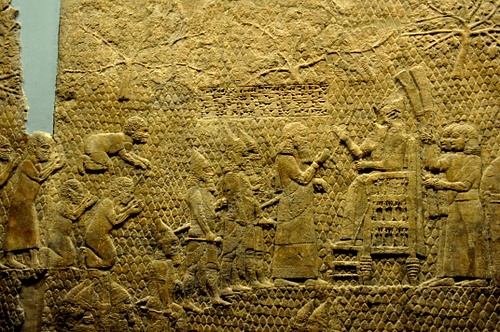
Sennacherib (r. 705-681 BCE)
He was followed by his son Sennacherib who campaigned with his army widely and ruthlessly, conquering Israel, Judah, and the Greek provinces in Anatolia. His siege of Jerusalem is detailed on the "Taylor Prism" (discovered in 1830 by Britain's Colonel Taylor), a cuneiform block describing Sennacherib's military exploits in which he claims to have captured 46 cities and trapped the people of Jerusalem inside the city until he overwhelmed them.
His account is contested, however, by the version of events described in the biblical book of II Kings, chapters 18-19, II Chronicles 32:21, and Isaiah 37, where it is claimed that Jerusalem was saved by divine intervention and Sennacherib's army was driven from the field. The biblical account does relate the Assyrian conquest of the region, however.
Sennacherib's military victories increased the wealth of the empire beyond what Sargon II had accomplished, even though his reign was marred by persistent military campaigns against Babylon and the Elamites. After his father's death, he moved the capital from Sargon's city of Dur-Sharrukin to Nineveh and built what was known as “the Palace without a Rival”. He beautified and improved upon the city's original structure, planting orchards and gardens. Scholar Christopher Scarre writes:
Sennacherib's palace had all the usual accoutrements of a major Assyrian residence: colossal guardian figures and impressively carved stone reliefs (over 2,000 sculptured slabs in 71 rooms). Its gardens, too, were exceptional. Recent research by British Assyriologist Stephanie Dalley has suggested that these were the famous Hanging Gardens, one of the Seven Wonders of the Ancient World. Later writers placed the Hanging Gardens at Babylon, but extensive research has failed to find any trace of them. Sennacherib's proud account of the palace gardens he created at Nineveh fits that of the Hanging Gardens in several significant details. (231)
Babylon had been a persistent problem throughout Sennacherib's reign, however, and he finally grew tired of dealing with it. Ignoring the lessons of the past, and not content with his great wealth and the luxury of the city, Sennacherib drove his army against Babylon, sacked it, and looted the temples. As earlier in history with Tukulti-Ninurta I (r. 1244-1208 BCE), the looting and destruction of the temples of Babylon was seen as the height of sacrilege by the people of the region and also by Sennacherib's sons who assassinated him in his palace at Nineveh in order to placate the wrath of the gods.
Sennacherib had chosen his youngest son, Esarhaddon, to succeed him in 683 BCE, and this did not sit well with his older brothers. While their motive in murdering their father could well have been their desire for power (and to cut off their younger brother's hopes for the crown), they would have needed some kind of justification for the act, and their father's sack of Babylon provided the rationalization.
Esarhaddon (r. 681-669 BCE)
Sennacherib's son Esarhaddon took the throne, defeated his brother's factions in a six-week civil war, and then executed his brothers' families, associates, and anyone who had joined against him. With his rule now secure, one of his first projects was to rebuild Babylon. He issued an official proclamation, which claimed that Babylon had been destroyed by the will of the gods owing to the city's wickedness and lack of respect for the divine. Nowhere in his proclamation does it mention Sennacherib or his role in the destruction of the city, but it makes clear that the gods chose Esarhaddon as the divine means for restoration:
Once during a previous ruler's reign there were bad omens. The city insulted its gods and was destroyed at their command. They chose me, Esarhaddon, to restore everything to its rightful place, to calm their anger, and soothe their rage.
The empire flourished under his reign. He successfully conquered Egypt which Sennacherib had tried and failed to do (because, according to Herodotus II.141, field mice ate through the strings of Sennacherib's archer's bows, their quivers, and the soldier's shield straps the night before battle). Esarhaddon established the empire's borders as far north as the Zagros Mountains (modern-day Iran) and as far south as Nubia (modern Sudan) with a span including the Levant (modern day Lebanon to Israel) through Anatolia (Turkey). His successful military campaigns, and careful maintenance of the government, provided the stability for advances in medicine, literacy, mathematics, astronomy, architecture, and the arts. Historian Will Durant writes:
In the field of art, Assyria equaled her preceptor Babylonia and in bas-relief surpassed her. Stimulated by the influx of wealth into Ashur, Kalakh, and Nineveh, artists and artisans began to produce – for nobles and their ladies, for kings and palaces, for priests and temples – jewels of every description, cast metal as skilfully designed and finely wrought as on the great gates at Balawat, and luxurious furniture of richly carved and costly woods strengthened with metal and inlaid with gold, silver, bronze, or precious stones. (278)
In order to secure the peace, Esarhaddon entered into vassal treaties with the Persians and the Medes, requiring them to submit in advance to his successor. Further, Esarhaddon's mother, Zakutu (l. c. 728-c. 668 BCE) issued her treaty in 670 or 668 BCE, the Loyalty Treaty of Naqi'a-Zakutu, which compelled the Assyrian court and the subject territories to accept Ashurbanipal as king and support his reign. This ensured the easy transition of power when Esarhaddon died in 669 BCE on campaign in Egypt, and rule passed to the last great Assyrian king, Ashurbanipal.
Ashurbanipal (r. 668-627 BCE)
Ashurbanipal was the most literate of the Assyrian rulers and is probably best known in the modern day for the vast library he collected at his palace at Nineveh. Though a great patron of arts and culture, Ashurbanipal could be just as ruthless as his predecessors in securing the empire and intimidating his enemies. Scholar Paul Kriwaczek comments:
Which other imperialist would, like Ashurbanipal, have commissioned a sculpture for his palace with decoration showing him and his wife banqueting in their garden, with the struck-off head and severed hand of the King of Elam dangling from trees on either side, like ghastly Christmas baubles or strange fruit? (208)
He decisively defeated the Elamites, completed his father's conquest of Egypt (though Egypt would successfully throw off Assyrian rule later), and expanded the empire further to the east and north. Elam had long posed a problem for the Assyrian Empire, and Ashurbanipal had already defeated them in battle once. In 648/647 BCE, Elam's king died and the country became divided by civil war as different factions fought for the throne. Ashurbanipal saw an opportunity to finally defeat his old enemy and drove his army again into Elam. Scholar Susan Wise Bauer writes:
Elamite cities burned. The temples and palaces of Susa were robbed. For no better reason than vengeance, Ashurbanipal ordered the royal tombs opened and the bones of the kings bundled off into captivity. (414)
When he sacked and destroyed the city of Susa in 647 BCE, he left behind a tablet which recorded his triumph over the Elamites:
Susa, the great holy city, abode of their gods, seat of their mysteries, I conquered. I entered its palaces, I opened their treasuries where silver and gold, goods and wealth were amassed... I destroyed the ziggurat of Susa. I smashed its shining copper horns. I reduced the temples of Elam to naught; their gods and goddesses I scattered to the winds. The tombs of their ancient and recent kings I devastated, I exposed to the sun, and I carried away their bones toward the land of Ashur. I devastated the provinces of Elam and on their lands I sowed salt.
Anyone with even the slightest claim to the throne was captured and brought back to Nineveh as a slave. In keeping with Assyrian policy, Ashurbanipal then re-located enormous numbers of the population throughout the region and left the cities empty and the fields barren. Bauer writes:
Ashurbanipal did not rebuild after the wrecking of the country. He installed no governors, he resettled none of the devastated cities, he made no attempt to make this new province of Assyria anything more than a wasteland. Elam lay open and undefended. (414)
This would later prove to be a mistake, as the Persians slowly took over the territory which had once been Elam and proceeded to re-build and fortify the cities. In time, they would help topple the Assyrian Empire.
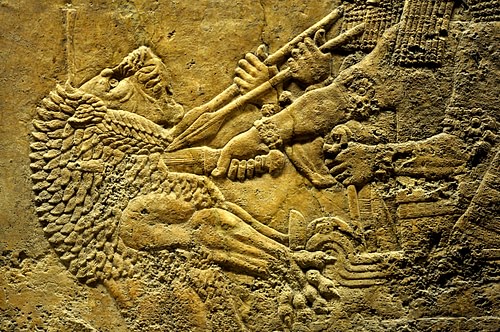
Just prior to Ashurbanipal's Elam campaign, his brother, Shamash-shum-ukin, who ruled Babylon, had revolted. He had secretly been in league with the Elamites and had actually encouraged their invasion of Assyria earlier in Ashurbanipal's reign. Ashurbanipal marched on Babylon and lay siege to the city for the next four years.
Inscriptions from the time relate what the defenders of Babylon endured behind the walls: “They ate the flesh of their sons and daughters because of starvation.” When the city fell, those who had survived so long were cut down by the Assyrian soldiers and, Ashurbanipal writes, “The rest of those living I destroyed…and their carved-up bodies I fed to dogs, to pigs, to wolves, to eagles, to birds of the heavens, to fishes of the deep.” Shamash-shum-ukin set himself on fire in his palace in order to escape capture. Ashurbanipal then set an Assyrian government official named Kandalu on the throne of Babylon.
After the siege of Babylon and the destruction of Elam, Ashurbanipal turned his attention to one of his great interests: books. Recognizing the importance of preserving the past, he sent envoys to every point in the lands under his control and had them retrieve or copy the books of that city or town, bringing all back to Nineveh for the royal library.
While not the first king to collect books, he was the first to make such a collection a priority. Ashurbanipal claimed to be able to read cuneiform script in both Akkadian and Sumerian and his collection of writings was vast. According to Kriwaczek, "Ashurbanipal went further than mere ability to read and claimed complete mastery of all the scribal arts" (250). In his own words, Ashurbanipal claimed:
I, Ashurbanipal, within the palace, understood the wisdom of Nabu [the god of learning]. All the art of writing of every kind. I made myself the master of them all. I read the cunning tablets of Sumer and the dark Akkadian language which is difficult to rightly use; I took my pleasure in reading stones inscribed before the flood. The best of the scribal art, such works as none of the kings who went before me had ever learnt, remedies from the top of the head to the toenails, non-canonical selections, clever teachings, whatever pertains to the medical mastery of [the gods] Ninurta and Gala, I wrote on tablets, checked and collated, and deposited within my palace for perusing and reading.
Kriwaczek further notes that this is no idle boast of the king, as there is actual proof that Ashurbanipal could compose in cuneiform and cites tablets which are signed by the author as "Ashurbanipal, King of Assyria". By the time of his death, his library would house over 30,000 clay tablets upon which were written some of the greatest masterpieces of Mesopotamian literature, including The Epic of Gilgamesh and the Enuma Elish, the Babylonian tale of creation.
Decline & Fall
Ashurbanipal ruled over the empire for 42 years and, in that time, campaigned successfully and ruled efficiently. The empire had grown too large, however, and the regions were overtaxed. Further, the vastness of the Assyrian domain made it difficult to defend the borders. As great in number as the army remained, there were not enough men to keep garrisoned at every significant fort or outpost.
When Ashurbanipal died in 627 BCE, the empire began to fall apart. His sons and successors Ashur-etli-Ilani, Sin-Shar-Ishkun, and Ashur-uballit II, all ineffective rulers, fought each other for the throne. While they were struggling for control of the empire, that very empire was slipping away. The territories under Assyrian rule saw their chance for independence and took it; regions began to successfully break away. The rule of the Assyrian Empire was seen as overly harsh by its subjects, in spite of whatever advancements and luxuries being an Assyrian citizen may have provided, and former vassal states rose in revolt.
In 612 BCE, Nineveh was sacked and burned by a coalition of Babylonians, Persians, Medes, and Scythians, among others (as was Ashur, Kalhu, and the other cities of the Assyrians). The destruction of the palace brought the flaming walls down on the library of Ashurbanipal and, although it was far from the intention, preserved the great library, and the history of the Assyrians, by baking hard and burying the clay tablet books. Kriwaczek writes:
Thus did Assyria's enemies ultimately fail to achieve their aim when they razed Ashur and Nineveh in 612 BCE, only fifteen years after Ashurbanipal's death: the wiping out of Assyria's place in history. (255)
Still, the destruction of the great Assyrian cities was so complete that, within two generations of the empire's fall, no one knew where the cities had been.
The ruins of Nineveh were covered by the sands and lay buried for the next 2,000 years. The Sargonid Dynasty had brought the Assyrian Empire to its highest peak of success as a political and military entity but, as later with Rome, the empire had simply grown too large to maintain.
Historians have speculated that this may be why Ashurbanipal never went back to re-conquer Egypt after it revolted against Assyrian rule; he may have understood that the empire was already too large to rule efficiently. He was the last king who was able to hold the empire together cohesively but, even if his sons had been better men and rulers, the empire could not have survived very much longer; it had simply grown too large and broke apart under the weight of that vast expanse.
